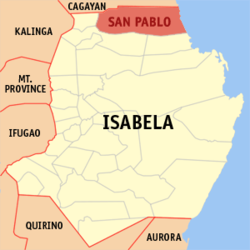San Pablo Cabagan Viejo | |
|---|---|
| Municipality of San Pablo | |
 San Pablo de Cabagan Church Ruin | |
 Map of Isabela with San Pablo highlighted | |
 Interactive map of San Pablo | |
Location within the Philippines | |
| Coordinates: 17°26′52″N121°47′42″E / 17.4478°N 121.795°E | |
| Country | Philippines |
| Region | Cagayan Valley |
| Province | Isabela |
| District | 1st district |
| Established | January 1, 1910 (as San Pablo) [1] |
| Named after | St. Paul the Apostle [2] |
| Barangays | 17 (see Barangays) |
| Government | |
| • Type | Sangguniang Bayan |
| • Mayor | Antonio N. Miro, Jr. |
| • Vice Mayor | Antonio Jose T. Miro III |
| • Representative | Antonio T. Albano |
| • Electorate | 17,489 voters (2025) |
| Area | |
• Total | 637.90 km2 (246.29 sq mi) |
| Elevation | 41 m (135 ft) |
| Highest elevation | 168 m (551 ft) |
| Lowest elevation | 14 m (46 ft) |
| Population (2024 census) [5] | |
• Total | 26,462 |
| • Density | 41.483/km2 (107.44/sq mi) |
| • Households | 5,867 |
| Economy | |
| • Income class | 2nd municipal income class |
| • Poverty incidence | 19.47 |
| • Revenue | ₱ 298 million (2022) |
| • Assets | ₱ 645.1 million (2022) |
| • Expenditure | ₱ 252 million (2022) |
| • Liabilities | ₱ 124.9 million (2022) |
| Service provider | |
| • Electricity | Isabela 2 Electric Cooperative (ISELCO 2) |
| Time zone | UTC+8 (PST) |
| ZIP code | 3329 |
| PSGC | |
| IDD : area code | +63 (0)78 |
| Native languages | Ibanag Ilocano Tagalog |
| Website | www |
San Pablo, officially the Municipality of San Pablo (Ibanag : Ili nat San Pablo; Ilocano : Ili ti San Pablo; Tagalog : Bayan ng San Pablo), is a municipality in the province of Isabela, Philippines. According to the 2024 census, it has a population of 26,462 people. [7]
Contents
- History
- Spanish occupation
- American occupation
- Japanese occupation
- Philippine independence
- Geography
- Barangays
- Climate
- Demographics
- Economy
- Culture
- Government
- Local government
- Elected officials
- Congress representation
- Education
- Primary and elementary schools
- Secondary schools
- References
- External links


